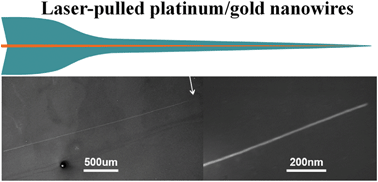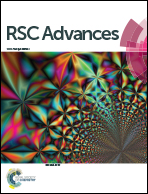Laser-pulled ultralong platinum and gold nanowires†
Abstract
We report the preparation and characterization of single platinum and gold nanowires with lengths up to 5 millimeters. Quartz-sealed platinum and gold nanowires are fabricated by drawing a short piece of the corresponding microwire using a highly reproducible laser pulling procedure. Bare metal nanowires are prepared by hydrofluoric (HF) acid etching of the quartz encapsulation. We show that these nanowires have cylindrical shape and taper down to an observed diameter as small as 10 nm for platinum and 40 nm for gold, yielding exceptionally high aspect ratios. X-ray diffraction (XRD) analysis indicates that both the gold and platinum nanowires exhibit a significant preference for development of the {111} crystal face in the axis normal to the nanowire length, whereas the {200} crystal face is nearly absent in this axis which is supported by Transmission Electron Microscopy (TEM) analysis. Quartz-sealed nanowires can be easily manipulated and arranged into complex patterns with an increasing number of contact points. Electrical properties of single nanowires were measured at nearly 0.5 mm lengths at room temperature. Each of the samples tested was found to have a resistivity approaching the bulk metal value and high observed current densities before wire failure. The grain boundary reflection coefficient was calculated on single laser-pulled nanowires to be R = 0.616 for gold and R = 0.259 for platinum.


 Please wait while we load your content...
Please wait while we load your content...